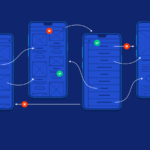Animations and transitions can add dynamic visual effects to your web applications, making them more engaging and user-friendly. JavaScript provides various methods and libraries to create these effects. In this blog post, we’ll explore how to implement JavaScript animations and transitions, including basic techniques, best practices, and popular libraries.
1. Introduction to Animations and Transitions
Animations involve continuous changes to an element’s properties over time, while transitions involve smooth changes between two states. Both can significantly improve user experience by providing visual feedback and enhancing interaction.
2. Creating Basic Animations with JavaScript
JavaScript allows for direct manipulation of CSS properties to create animations. Here’s a simple example to animate an element’s position:
Example: Basic Animation
<html>
<head>
<title>Basic JavaScript Animation</title>
<style>
#box {
width: 100px;
height: 100px;
background-color: red;
position: absolute;
top: 0;
left: 0;
}
</style>
</head>
<body>
<div id="box"></div>
<button onclick="moveBox()">Move Box</button>
<script>
function moveBox() {
const box = document.getElementById('box');
let position = 0;
const interval = setInterval(() => {
if (position >= 500) {
clearInterval(interval);
} else {
position += 5;
box.style.left = position + 'px';
}
}, 20);
}
</script>
</body>
</html>
Explanation:
- This code snippet moves a red box horizontally across the screen.
setIntervalis used to increment the box’sleftposition, creating a smooth animation effect.
3. Implementing CSS Transitions with JavaScript
CSS transitions offer a simple way to animate changes between two states. JavaScript can be used to trigger these transitions by adding or removing CSS classes.

Example: CSS Transitions
<html>
<head>
<title>CSS Transition Example</title>
<style>
#box {
width: 100px;
height: 100px;
background-color: red;
transition: transform 0.5s ease;
}
.move {
transform: translateX(200px);
}
</style>
</head>
<body>
<div id="box"></div>
<button onclick="toggleMove()">Toggle Move</button>
<script>
function toggleMove() {
const box = document.getElementById('box');
box.classList.toggle('move');
}
</script>
</body>
</html>
Explanation:
- The CSS
transitionproperty animates thetransformproperty of the box. - JavaScript toggles the
moveclass to trigger the transition.
4. Using Animation Libraries
JavaScript libraries can simplify the creation of complex animations. Popular libraries include:
- GSAP (GreenSock Animation Platform): Provides a robust set of tools for advanced animations.
- Anime.js: A lightweight library with support for timelines and complex animations.
- Three.js: Useful for 3D animations and WebGL.
Example: Animation with GSAP
<html>
<head>
<title>GSAP Animation</title>
<script src="https://cdnjs.cloudflare.com/ajax/libs/gsap/3.9.1/gsap.min.js"></script>
</head>
<body>
<div id="box" style="width: 100px; height: 100px; background-color: red; position: relative;"></div>
<button onclick="animateBox()">Animate Box</button>
<script>
function animateBox() {
gsap.to("#box", { duration: 1, x: 300 });
}
</script>
</body>
</html>
Explanation:
- GSAP simplifies animation by providing a powerful API to animate the
xposition of the box.
5. Best Practices for JavaScript Animations
- Performance Optimization: Use
requestAnimationFramefor smoother animations and avoid layout thrashing. - Minimize Reflows: Change styles that affect layout sparingly to avoid performance issues.
- Accessibility: Ensure animations do not negatively impact users with motion sensitivities. Provide options to reduce or disable animations if necessary.
6. Conclusion
JavaScript provides versatile tools for implementing animations and transitions, enhancing the visual appeal and interactivity of web applications. Whether using basic JavaScript methods or leveraging powerful libraries like GSAP, you can create engaging and smooth animations. By understanding and applying best practices, you can ensure your animations are both effective and performant.
With JavaScript, you can bring your web pages to life through engaging animations and transitions, improving user experience and interaction. Whether you’re using native methods or advanced libraries, mastering these techniques will help you create dynamic and visually captivating applications.











